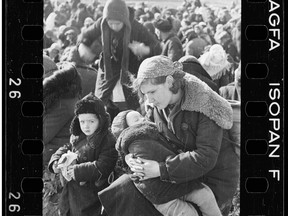"Auschwitz. Not long ago. Not far away"
"I had no idea where we were. It was unreal and beyond my imagination.""After being tattooed [133628] and inducted as a prisoner and losing my identity, I thought this was hell on Earth, from which I had little or no hope of getting out. I was in total despair.""Only my father's presence gave me some hope."Nate Leipciger, 96, from Sosnowiec, Poland"[The artifacts, augmented by survivors' recorded testimonies], are the traces of genocide, the remnants of a murdered people, and the material evidence of crimes against humanity.""They are what remain despite the perpetrators' attempts to conceal their crimes."Paul Salmon, curator, exhibit catalogue, "Auschwitz. Not long ago. Not far away""It's not easy to go to a museum to learn about the particular story of Auschwitz, but sometimes the things that are more difficult are the ones that are more necessary.""We knocked on many doors. I never got no for an answer."Luis Ferreiro, director, Musealia, Spain"[The Royal Ontario Museum's mission is] to help people understand the past, make sense of the present, and come together to shape a shared future.""[With the Auschwitz exhibit], we could not imagine an exhibition that more materially fulfilled our mission.""[There is a deliberate attempt to avoid] gratuitous depictions of violence."Josh Basseches, museum director and CEO, ROM
 |
| Jews from Lubny, Ukraine, shortly before their murder by an Einsatzgruppe, 1941. This photo is one of the items in the exhibit Auschwitz: Not long ago. Not far away. Photo by Musealia |
In
2008, Luis Ferreiro, director of his family's Spanish company Musealia,
in mourning after the death of his 26-year-old bother, read
psychotherapist and philosopher Viktor Frankl's book, Man's Search for Meaning.
It gave him comfort. Viktor Frankl was a survivor of Auschwitz. It was
there that his pregnant wife, parents and his brother perished in Nazi
Germany's campaign to extinguish all Jewish life in Europe. The book's
story of survival and finding purpose in life despite the worst possible
circumstances, resonated with Mr. Ferreiro.
Although not a Jew, he took inspiration from the writer's message and decided to pursue "a moral necessity to do something. It was always about Auschwitz for me".
He collaborated with the Auschwitz Museum and spent time tracking down
other potential involvement in a long but rewarding process to showcase
human survival in the most obscene, inhumane period of modern human
history. His decision to dedicate himself to this project gave purpose
to his own life, through his grief.
 |
The
end product of his research and organizing of an exhibit to feature the
Auschwitz death camp during the years of the Holocaust, in the Second
World War, opened in 2017 in Madrid. Since then the exhibit has toured
in New York, Kansas City the Ronald Reagan Library in Simi Valley,
Malmo, Sweden, and Boston. Between 1.4 and 2 million people have viewed
the exhibit, according to Mr. Ferreiro's estimation. During his search
for collaborators for his project, Mr. Ferreiro discovered Robert Jan
van Pelt, professor at the University of Waterloo, among the world's
leading experts on Auschwitz, who became the exhibit's chief curator.
At
Birkenau, the largest of the nearly fifty sub-camps collectively known
as Auschwitz, 96-year-old Toronto resident, Nate Leipciger, Holocaust
survivor, who has over the years dedicated himself to educating the
public about the Holocaust, had lost his mother and sister, murdered
along with eight other members of his extended family. Their lives were
taken in the gas chambers of Birkenau.
Of
the Nazi death camps scattered throughout Europe, Auschwitz was the
largest, most notorious and deadliest. At liberation, photographs of
skeletal inmates in striped uniforms and dazed eyes, many too weak to
rise from their serried bunks, were seen worldwide as examples of the
Nazi atrocities perpetrated against Europe's Jews in the slaughter of
six million of Europe's Jewish communities.
 |
Details like crammed boxcars, crematoria, belching chimneys of human ash, barbed wire enclosures, a gate whose legend read "Arbeit Macht Frei"
have become symbolic of the Holocaust. 1.3 million people were deported
to Auschwitz in the four years of 1940 to 1944; 1.1 million were Jews.
900,000 were gassed soon after their arrival in packed rail boxcars.
Others were used for slave labour until they died of exhaustion and
malnutrition. Some 75,000 non-Jewish Poles, 21,000 Roma, 14,000 Soviet
prisoners of war and up to 15,000 of other categories including
criminals, homosexuals, Jehovah's Witnesses and "undesirables", were
also murdered there.
On January 10, preceding the 80th anniversary of the camp's liberation on January 27 (annual International Holocaust Remembrance Day),
the exhibit will open at the Royal Ontario Museum in Toronto. Over 500
original artifacts, along with hundreds of photographs, charts,
drawings, correspondence and diagrams will be shown at the exhibit, most
of them on loan from the Auschwitz-Birkenau Memorial and Museum, and
from over 20 other institutions.
Among
many other items are receptacles that once contained Zyklon B pellets.
Belongings of newly-arrived prisoners of the time, are heaped within a
large glass case, comprised of everyday common personal items such as
shaving material, perfume bottles, eyeglasses, hair brushes, bowls and
buttons. Personal property items of the victims were in such abundance
they were stored within 30 barracks, referred to as "Kanada", a country
imagined to be brimful of wealth.
During
the Holocaust an estimated 1.5 million Jewish children were murdered or
died of deprivation. At a time of steeply rising antisemitism all over
the world, a time when knowledge of the Holocaust is fading, the exhibit
strives to reawaken a disinterested world's memory and conscience. The
exhibit will be on display until September 1. The ROM is its only
Canadian destination. The museum has suspended an admission charge for
Grades 6 - 12 students in organized school visits.

Labels: Annihilation of Jewish Life, Auschwitz-Birkenau, Europe's Jews, Gas Chambers, Holocaust, Nazi Germany, Occupied Poland, World War II
0 Comments:
Post a Comment
<< Home